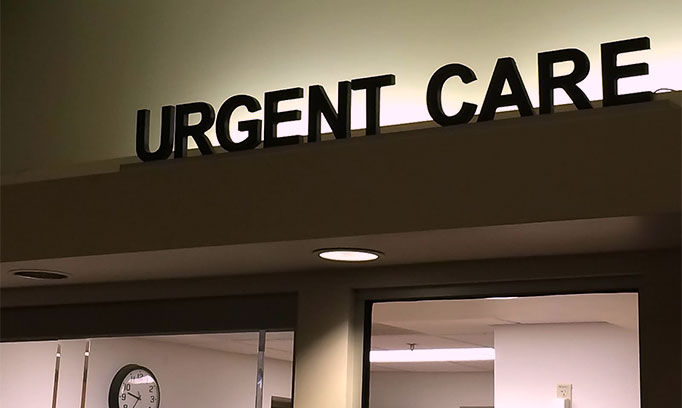Urgent Care vs. Health care: Which Is Right for Your Requirements?
Urgent Care vs. Health care: Which Is Right for Your Requirements?
Blog Article
A Comprehensive Guide to Using Urgent Care Prompt Treatment of Usual Ailments and Conditions
Immediate care facilities play an essential role in the medical care landscape, using a critical option for clients looking for timely treatment for non-life-threatening problems. What remains to be discovered are the particular problems that require a check out to urgent treatment and the advantages of selecting this alternative over traditional emergency situation services.
Recognizing Urgent Care Provider

In addition to treating urgent problems, several centers supply diagnostic solutions, such as X-rays and research laboratory testing, which streamline client care and promote quicker diagnoses. Recognizing how to properly utilize immediate treatment services can cause improved health and wellness end results, as clients get the essential care immediately without frustrating medical care service providers or emergency situation solutions. This model boosts the general efficiency of the medical care system, guaranteeing that patients get ideal care in a timely way.
Usual Problems Dealt With
A broad variety of usual problems can be effectively handled at immediate treatment facilities, making them a hassle-free option for clients seeking instant clinical interest. These centers are outfitted to handle a variety of non-life-threatening problems that require prompt treatment.
Among the most frequently treated conditions are respiratory infections, including colds, influenza, and bronchitis. Urgent care facilities additionally address minor injuries, such as stress, fractures, and sprains, offering necessary treatment and stabilization. Additionally, skin problem like breakouts, insect attacks, and small burns are generally examined and treated.
Gastrointestinal issues, consisting of nausea or vomiting, throwing up, and diarrhea, typically prompt visits to immediate treatment, particularly when symptoms are intense. Immediate treatment carriers can additionally handle urinary system infections and other non-emergency ailments. Patients can obtain vaccinations and preventative care solutions, such as flu shots and take a trip immunizations, making immediate care an available resource for total health and wellness maintenance.
## When to Visit Urgent Treatment
Knowing when to check out an urgent care facility can dramatically improve the performance of your healthcare experience. Urgent treatment facilities are created to give instant attention for non-life-threatening conditions that need punctual medical treatment. Usual reasons to seek treatment at an immediate treatment center include small injuries, such as cracks, strains, and sprains, in addition to severe illnesses like the flu, strep throat, or urinary tract infections.
Furthermore, immediate treatment is appropriate for conditions that exhibit aggravating signs and symptoms yet are not extreme enough for an emergency clinic check out. For example, relentless throwing up, dehydration, or extreme discomfort that necessitates quick attention can all be effectively managed in this setting.
It from this source is necessary to set apart in between immediate treatment and emergency care; the latter is reserved for deadly situations, including chest discomfort, extreme blood loss, or loss of consciousness. Comprehending these distinctions not just simplifies your medical care trip however also reduces the burden on emergency situation solutions. By examining the seriousness of your condition accurately, you can make certain prompt and suitable healthcare, allowing for a quicker healing and improved health end results.
What to Anticipate Throughout Your Check Out
During your visit to an immediate care facility, you can anticipate a streamlined procedure created to address your clinical requirements efficiently. Upon arrival, you will commonly sign in at the reception workdesk, where you will give your individual information, insurance policy details, and a quick description of your symptoms. This preliminary step is vital for guaranteeing that your case is focused on appropriately.
Adhering to check-in, you may be asked to finish a medical background kind, outlining any kind of pre-existing conditions or drugs you are currently taking. As soon as your paperwork is total, a triage nurse will analyze your condition and figure out the urgency of your circumstance. This analysis will assist guide the speed at which you obtain care.
After triage, you will be seen by a doctor, that will perform an extensive exam and discuss your signs thoroughly. Relying on your diagnosis, the supplier might order tests, recommend drugs, or recommend a knockout post follow-up care. Throughout your check out, immediate treatment staff will aim to keep you notified concerning your therapy strategy and any required next actions, making sure a site link positive person experience.

Benefits of Picking Urgent Treatment
Immediate treatment centers supply a range of advantages that cater to people seeking prompt medical focus for non-life-threatening conditions. One of the main advantages is availability; many immediate treatment facilities run extended hours, consisting of nights and weekends, enabling people to receive treatment when traditional offices are shut.
Additionally, urgent treatment facilities are usually equipped to deal with a selection of common conditions, such as small injuries, infections, and illnesses, without the need for a visit. This ease is particularly helpful for people with busy routines or those that can not await a health care check out.
In addition, immediate care services have a tendency to be a lot more cost-efficient than emergency room check outs, with reduced costs and co-pays, making them a financially prudent choice. Numerous insurance coverage strategies cover immediate treatment brows through in a similar way to health care appointments. Overall, urgent care centers supply prompt, economical, and effective clinical care, making them an attractive option for individuals looking for immediate treatment.

Conclusion
Comprehending when to use immediate care can enhance individual end results and satisfaction. Eventually, the critical usage of urgent care contributes to a much more structured medical care experience, balancing quality care with comfort and price - urgent care.
Recognizing how to efficiently use urgent treatment solutions can lead to better wellness end results, as patients receive the required care immediately without frustrating key treatment providers or emergency services. Patients can receive vaccinations and preventive care services, such as influenza shots and take a trip booster shots, making immediate treatment an obtainable source for general health and wellness upkeep.
Typical reasons to seek care at an immediate treatment facility include minor injuries, such as sprains, strains, and cracks, as well as intense illnesses like the flu, strep throat, or urinary system infections.
One of the main advantages is ease of access; many immediate treatment facilities operate expanded hours, consisting of evenings and weekend breaks, allowing people to get care when typical workplaces are closed. Overall, immediate care facilities use timely, economical, and efficient clinical care, making them an enticing choice for individuals in demand of immediate therapy.
Report this page